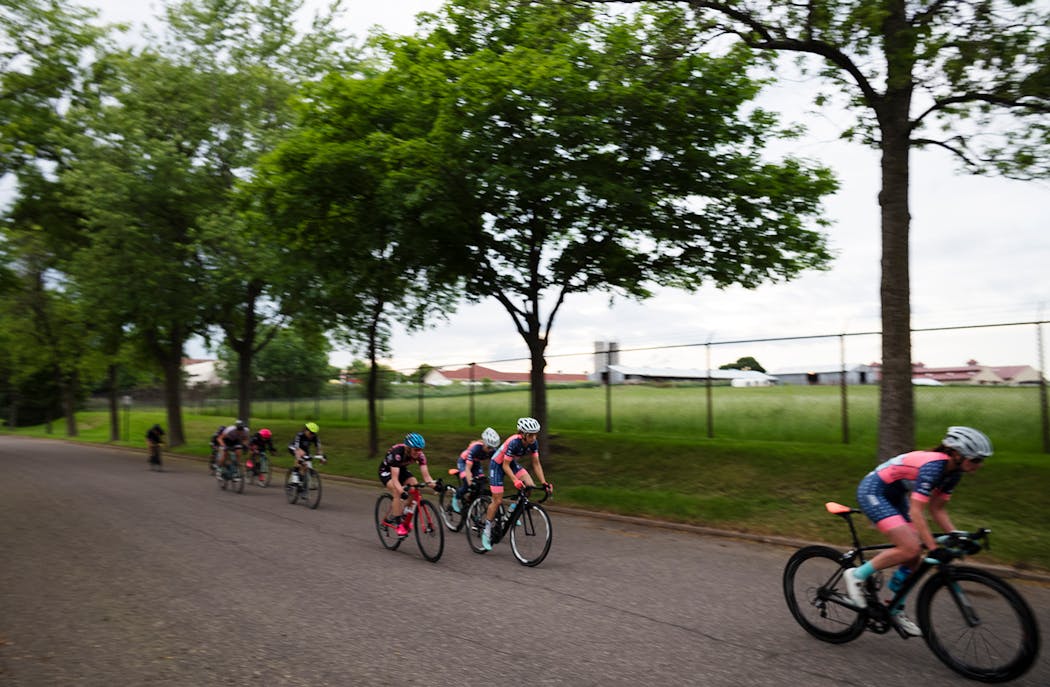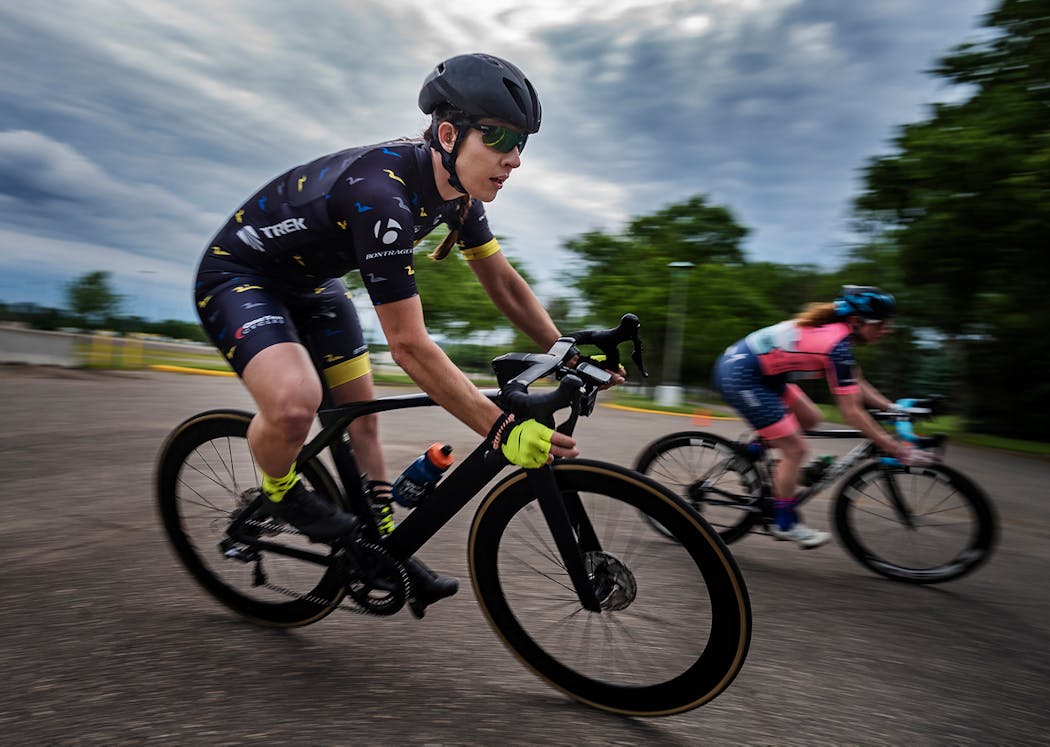Like a school of fish, Lycra-sleek riders flowed around the turn, bunching as they leaned into Machinery Hill. Sweeping around the north end of the Fairgrounds in St. Paul, the swarm strung out on the stretch of straight road, tires whirring on the asphalt. Breakaway riders flashed past in single file; 10 seconds later, the chase pack.
Fit-looking competitors from previous or upcoming races watched, draped over their bikes or slowly circling, or popping wheelies, the bikes mere extensions of their bodies.
It was Tuesday. If one had a road bike and a need for speed, the Machinery Hill Criterium Series — the State Fair Crit, as it's commonly known — was the place to be. And that's been true since the 1980s.
"I started racing in 1994," said Mike Delaney, who, with his timing company Endurance Promotions, organizes the Machinery Hill series. "We called it Tuesday Night Worlds because that's where everybody showed up."
So who's part of this Tuesday night world? On this particular evening in early June, about 84 showed up to race, men outnumbering women (only 18% of licensed racers are women), most between the ages of 20 and 50, with day jobs, children and an unfussy love of two-wheeled movement in all permutations — mountain biking, road racing, cyclocross, gravel riding, and of course, basic transportation. While first-timers can compete without being overwhelmed, Delaney said pros have stopped by for a midweek workout and found plenty of competition.
Thick with culture
Shane Kullman raced at the fairgrounds as a high schooler back in the mid-1980s. He has got a day job in IT but has helped Delaney since the 1990s with race registration. "It's not cheaper than Life Time fitness, but it's a whole lot more fun," Kullman said of bike racing. "It's as social as you want it to be, it's easy on the body. It doesn't matter how old I am [he's 46], it's still fun."
The five races of the evening progressed from least-experienced racers (Category 5, aka Cat 5) to most (Cat 1), with separate races for men and women. Announcer Jim Cullen kept up a steady patter of useful information — who was in the breakaway, who was chasing, why the heck team TacoCat was letting Orion go, and what lucky rider just won a growler from Town Hall Brewery for leading lap No. 5.
Anthony Hilligoss, 15, representing Northstar Development, competed in the men's Cat 3-4 race. With five laps of the fairgrounds roads to go, Hilligoss broke from the chase pack, trying to catch the lead group 20 seconds ahead. It was a calculated risk, he explained later — a solo rider sacrifices the 30% energy savings of drafting in the pack — but he felt the call of duty to his team.
"Unluckily, the pack chased me down," said the Eden Prairie teen, laughing. His boldness was nonetheless admired, especially because he had enough left in the tank to "win the field sprint," the first of the main pack to cross the line.
Bike racing is thick with lingo, team tactics, etiquette and data. Erin Ayala, one of nine women and 20 men on the Loon State Cyclists (sponsored by OneTen Cycles), gave an overview by phone before putting it all into practice.
"Etiquette is largely a matter of safety," said Ayala, a metro sport psychologist. Swinging wide to flatten out the line of the turn, she said, lets a racer turn safely without losing a lot of speed. Divebombing is passing on the inside of a turn — a no-no. The safest place to pass is on a straight. Following close to the wheel in front of you is fine; overlapping wheels, not fine. "Taking a flyer" is using the draft from the pack to slingshot to the front. Don't slam on the brakes, Ayala advised — dramatic changes in speed are dangerous and frowned on. Pay attention to your surroundings and know your competitors, she said. If a sprinter breaks away, it may be best to let her go — she'll be back. But if a couple of teammates make a big move? Follow, and draft them.
"Your job is to get one of your teammates on the podium," Ayala said. "Teams sometimes nominate one person, a strong rider, to sit in and do as little work as possible during the race. Teammates protect them, they 'burn matches,' chasing down opposing riders who try to break from the pack, until the chosen one makes her move."
Ayala, 31, was a triathlete, but when she moved to Minnesota in 2016, she focused on her favorite, and strongest, of the three disciplines — cycling. Like most of the Tuesday night racers, she fits training and racing around her day job.
"I do some of my training at home on the [stationary] trainer which is good for building fitness, but you need to ride in a group to get racing experience," she said. "Everybody travels to races on the weekend — Tuesday nights are super popular. All the local cyclists are in town."
Though she wasn't fully recovered from a grueling 200-mile gravel race 10 days earlier, Ayala wouldn't miss the fairgrounds meeting, as much for the camaraderie as the midweek workout.
"It's a great community," Ayala said. "Women's fields are growing. You get to know people, drafting is easier, and it's just more fun if there are more people in the field."
Fellow Loon State cyclist Keri Turner morphed from racer to mom, taking over care of their 11-month-old daughter so her husband could warm up for the final race of the evening, men's Cat 1-2-3. Her path to bike racing went from running to cyclocross to road racing, which she found "kind of scary because you have to be right on someone's wheel." She admitted, crashes happened in cyclocross, but it hurt less to fall in the dirt.
Mixing it up
Notably larger in number and hair-raisingly fast (the winner averaged 26.2 mph), the last race of the evening played out in classic fashion — five carbon-framed riders from three different teams broke away from the pack fairly early in the 50-minute race (races are based on a set amount of time; based on their speed in the first two laps, riders are informed on the third circuit how many remain). The breakaway of five, followed by the main pack and some stragglers persisted until the final meters when racers popped out of their saddles and applied serious power to their pedals.
Logan Grace prevailed in that sprint. Grace, 24, has been racing for six years, five of them with the University of Minnesota's club. A Cat 1 racer with Vol Gas Racing, he regularly travels to races on the weekends, mixing it up with pros who are doing that for a living.
"Just doing it on the weekend is fun enough," said Grace, who is a research and development engineer at a medical device company. "The pros have everything provided for them, but there's more road rash and expectation to perform. And usually, a day job pays better. Most of us are happy with our day jobs, that we can train and race and still give those guys a run for their money."
Sarah Barker is a freelance writer. She lives in St. Paul.

Wolves vs. Suns: Here are the match-ups . . . and a series prediction




